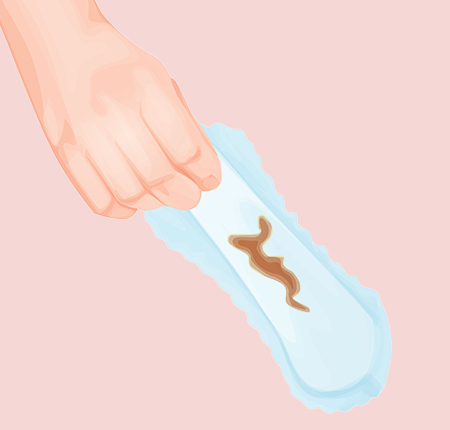
Women are different, their vaginal discharge is different. Your vagina can produce more or less secretions than others, and surely you have often wondered if the color or consistency of vaginal discharge is normal or if it needs to be checked.
The vagina is a dynamic ecosystem with a specific balance between bacteria, pH and moisture. This balance is sensitive and can be easily influenced by internal or external factors. It is important for us to understand the messages our body is sending us and to give vaginal secretions the attention they deserve.
What does vaginal discharge mean? White / Brown / Yellow Vaginal Secretions - What is normal?
Vaginal discharge is fluid secreted by tiny glands in the vagina and cervix. This fluid drains from the vagina every day to remove old cells and debris, keeping the vagina and reproductive tract clean and healthy. 
Most of the time, vaginal discharge is perfectly normal. The amount can vary, as can the smell and color, depending on the period of the menstrual cycle. For example, there will be more discharge when you are ovulating, breastfeeding or sexually aroused. The smell can also be different when you are pregnant or have neglected personal hygiene.
None of these changes are cause for concern. However, if the smell, color or consistency seems much different, if vaginal itching or burning occurs, it is possible to talk about a bacterial imbalance caused by an infection or other condition.
Types of vaginal secretions (discharges) according to color
There are several different types of vaginal discharge. Classification is done according to color and consistency. Some types of discharge are perfectly normal, while others may indicate a condition that requires medical attention.
Brown/brown vaginal discharge (blood)
This color is normal for vaginal discharge when it occurs during or immediately after menstruation. If it occurs between periods, it can be a sign of pregnancy. If you want to know even more about the first signs of pregnancy, we have an article for you.
White / whitish vaginal discharge
If they occur at the beginning or end of the menstrual cycle, whitish vaginal discharge is normal and a sign of healthy lubrication.
Creamy white odorless discharge
As long as they are odorless, do not change consistency, and are not accompanied by itching, stinging, or other signs of infection, white discharge is normal. They generally have a thick, creamy and sticky texture and are not a cause for concern.
It is possible to notice a white discharge even during pregnancy. This is called leukorrhea and helps maintain a healthy intimate flora, supports pH balance and prevents the build-up of harmful bacteria. In the 2nd trimester, such secretions can appear daily, in the amount of a teaspoon.
However, if the secretions become abundant, whether you are pregnant or not, it is good to talk to your gynecologist to check that everything is okay.
White cheesy discharge without odor
We know, you recognize most infections by the unpleasant smell of vaginal secretions. But in the case of fungal infections such as candidiasis, the smell is not the only indicator. The cheesy texture may indicate Candida albicans infection even if you don't have foul-smelling or greenish-yellow discharge.
The likelihood of a candida infection is even higher if the cheesy discharge is accompanied by symptoms such as irritation in the vaginal area, itching or stinging.
Indeed, white, cheesy, odorless discharge may be a specific sign of pregnancy and not a problem. But it is best to talk to your doctor immediately if you notice such a change, to eliminate any suspicion.
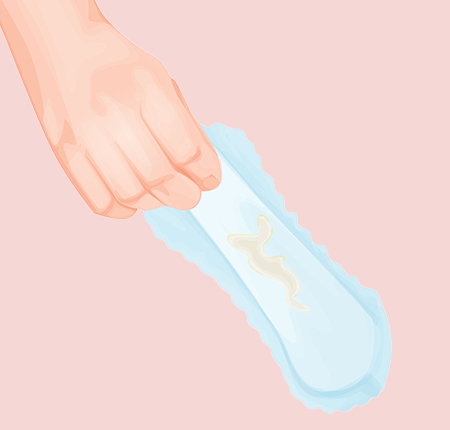
When does white vaginal secretion become an alarm signal?
However, if itching or irritation occurs, if the smell is unusual and the consistency becomes creamy, with a cheesy appearance, you should consult a doctor. Such symptoms can be signs of infection called vaginal candidiasis. Although the name sounds scary, everything you need to know from the types of candidiasis, to how to protect yourself and, if necessary, how to treat yourself, you can find in our article .
Yellow / greenish vaginal discharge
If the discharge has a very slight yellow tint, it may not indicate a problem. This is especially likely if the timing coincides with a change in diet or dietary supplements.
Discharge that is a darker shade of yellow, yellowish-green, or green usually signals a bacterial or sexually transmitted infection. See a doctor immediately if your vaginal discharge is thick, clumpy, or has a foul odor.
Odorless yellow discharge
Yellow discharge is a type of discharge you want to talk to your doctor about. The possibilities are many, and it's easy to mistake a healthy yellow discharge for one caused by infection.
After your vagina cleans itself and removes the secretions, their contact with air can change their color, which is why you end up seeing them yellow. If the discharge is clear, odorless, has only a slight yellow tinge and you have no other symptoms, it may be normal.
But it could just as well be a sign of a sexually transmitted infection, pelvic inflammatory disease, other types of infections, or even a first symptom of pregnancy, so further investigation is needed.
Odorless greenish-yellow discharge
Yellow discharge can be normal, and even your recent diet can change the color of your discharge. But when a shade of green also appears in the landscape, the chances are very high that a greenish-yellow discharge, even without an odor, indicates the presence of an infection. The greenish color is the body's natural inflammatory response to infection.
Generally, conditions that cause a greenish or dark yellow discharge are bacterial vaginosis and sexually transmitted diseases. Other characteristics by which you realize that the greenish secretions are caused by infections are the thin or foamy texture and the presence of other uncomfortable symptoms (itching, irritation, etc.).
Pink vaginal discharge / pink discharge
Pink vaginal discharge usually contains blood and is normal at times such as: after childbirth (represents the cleaning of the uterine lining), during ovulation or before menstruation (known as "spotting"). This pink color can also appear at the beginning of pregnancy or when sexual intercourse was not exactly pink and caused small irritations in the vagina. If instead you are pregnant and notice heavier bleeding, it is best to talk to your doctor to check if it is normal or if your baby is in danger. Don't panic, not all bleeding during pregnancy is harmful and I told you more about this topic HERE .
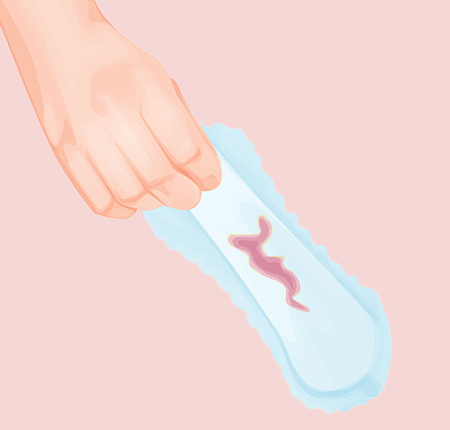
Black vaginal discharge
Black vaginal discharge is not usually synonymous with infection, but rather a hormonal or menstrual disturbance. Learn more about how hormonal imbalances manifest and what causes them HERE . The black color of vaginal discharge can be due to cells that the uterus was unable to expel during the previous menstrual cycle and usually occurs just before or immediately after menstruation. Sometimes this color can also be caused by changing hormonal contraception.
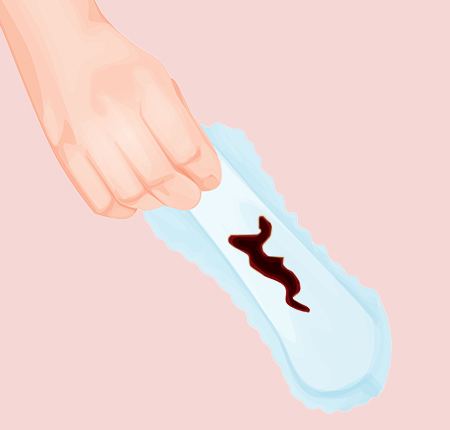
Clear / colorless vaginal discharge
A translucent, watery, colorless discharge is perfectly normal. It usually occurs at any time of the month and may be more abundant after intense physical activity. So that you can make the most of every moment, at ENROUSH we have created the perfect technology for organic intimate care every day, not just during your period. The daily absorbents, made of 100% certified organic cotton, with neutral pH and natural super-absorbent interior, are your daily support to forget your worries and have more time for..you! You can order them here and now or you can subscribe and we'll make sure you get the package with exactly what you need, exactly when you need it.
Types of vaginal secretions according to consistency
In addition to color, the consistency of vaginal secretions can vary depending on several factors, including hormonal changes or the occurrence of infections. Let's translate each texture to everyone's understanding.
Abundant vaginal discharge
If no other associated symptoms appear, heavy vaginal discharge is not a cause for concern. In addition, it is normal for the discharge to become more abundant with sexual arousal and ovulation. Also, the use of birth control pills and emotional stress can cause imbalances.
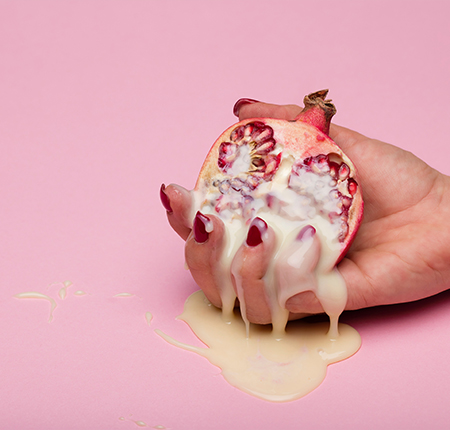
Cheesy vaginal discharge
Any cheesy discharge, especially associated with itching or irritation are symptoms of abnormal vaginal discharge. As it may be an infection, we recommend that you consult a gynecologist immediately.
Watery vaginal discharge/secretions
Watery vaginal discharge appears as a clear or translucent liquid. These secretions signal the elimination of bacteria and dead cells from inside the vagina and are normal as they protect the vaginal and urinary tract from infections. You can most often notice such discharges at ovulation, after intense physical exercise or during sexual excitement.

Gelatinous vaginal discharge
If the discharge is white transparent and gelatinous, it indicates a high amount of estrogen, as it occurs during ovulation, but it can also occur after or during sexual arousal. If we talk about a transparent gelatinous secretion during pregnancy, this can be a sign of the dilation of the cervix (also called the cervix).
Sticky vaginal discharge
A thick, sticky, white vaginal discharge between periods is often a normal phenomenon. It becomes a problem only when symptoms such as general weakness, headache, lower back pain also appear, in which case you should seek the opinion of a doctor.
Another situation where there may be a problem is if you notice spotting or bleeding in addition to these secretions. If it happens frequently, is heavy, or lasts for several days, period bleeding is not normal and requires medical attention. Read more about what is and what is not normal for bleeding between periods HERE .
Creamy vaginal discharge
Creamy white discharge acts as a barrier to protect the cervix from possible infections. As ovulation approaches, the white vaginal discharge will thin and become clear or milky. This secretion is a sign of fertility.

Abnormal vaginal secretions - How do we recognize them?
Normal vaginal discharge is a healthy way for the body to clean itself and a method of protecting the vagina. As I said before, variations in color and consistency are normal, while itching, irritation are signs of an infection.
A good practice for our health as women is to keep a journal where we can go over all the changes that occur throughout a menstrual cycle. This will help you take care of your body, and if changes occur, the causes will be able to be concretely analyzed, based on the information kept by you. How cool is that?
Vaginal discharge - Causes
It is good to remember that:
- Vaginal discharge is normal and varies throughout the menstrual cycle.
- It is normal for the discharge to become more abundant with sexual arousal and ovulation.
- Emotional stress and birth control pills can cause imbalances in vaginal secretions.
- Abnormal vaginal discharge is usually caused by the presence of an infection.
However, what factors influence the occurrence of a vaginal discharge?
Vaginal discharge caused by the menstrual cycle
Vaginal discharge is a natural phenomenon during the menstrual cycle, which maintains the balance of the flora in the vagina. These secretions vary most of the time depending on the day of the cycle:
- Days 1–5: At the beginning of the cycle, the discharge is usually red or bloody as the body sheds the lining of the uterus.
- Days 6-14: After a period, you may notice less vaginal discharge than usual. As the egg begins to develop and mature, the cervical mucus will become cloudy and white or yellow. It may feel sticky.
- Days 14–25: A few days before ovulation, the mucus will be thin and slippery, similar to the consistency of egg whites. After ovulation, the mucus will return to being cloudy, white or yellow, and possibly sticky.
- Days 25–28: Cervical mucus will become lighter and less noticeable before you get your next period.
Secretions from vaginal infections & diseases
Abnormal vaginal discharge is usually caused by the presence of an infection that, untreated, leads to various diseases. We talk about some of them here.
Fungal infections
Yeast infections can develop relatively easily inside the vagina and cause changes such as white, cheesy vaginal discharge, itching, inflammation around the vagina, burning sensation when urinating, pain during intercourse.
Sexually transmitted infections
Urogenital trichmoniasis is a sexually transmitted infection that affects both sexes. In women, in addition to the burning sensation, pain including in the urinary tubes and inflammation, the vaginal secretions are abnormal, yellow-green in color and with an unpleasant smell.
There are many other sexually transmitted infections that can cause yellow discharge or greenish discharge, and we have an article where we told you everything you need to know about sexually transmitted diseases .
Bacterial infections
Bacterial vaginitis occurs alongside candidiasis, trichmoniasis or urinary tract infections. Although sometimes the body does not show specific signs, when the infection advances, the vaginal secretions are homogeneous, yellow-gray in color, with an unpleasant smell.
gonorrhea
Abnormal vaginal discharge is one of the main symptoms of gonorrhea in women. They are yellow or greenish in color because they often contain pus. The shade is cloudy or opaque, and the texture is watery or very thin.
Gonorrhea is caused by infection with the bacterium Neisseria Gonorrhoeae and may be asymptomatic, or it may manifest as painful or burning sensations when urinating, abdominal pressure, bleeding after sexual intercourse, or changes in menstruation. Read on our blog everything you need to know about what gonorrhea is and how it is treated .
Chlamydia
The bacterium Chlamydia trachomatis, transmitted through unprotected sexual contact, is the one that causes the infection that bears its name. Chlamydia affects the cervix, uterus, fallopian tubes, but also the urethra, rectum, throat and eyes, and unusual vaginal discharge is one of the first and most obvious symptoms.
The secretions caused by Chlamydia are accompanied by an unpleasant smell, and can have several colors, from white and yellow to green and gray. Pyuria (or pus in the urine) is another symptom of Chlamydia infection.
Secretions caused by menopause
Menopause is a new stage in a woman's life when changes occur throughout the body, including vaginal discharge. A drop in estrogen levels makes the walls of the vagina thinner and drier, which causes vaginal dryness. If you have excessive vaginal secretions, you may have a vaginal infection and we recommend that you see a doctor.
Secretions caused by improper hygiene
Improper hygiene can significantly influence the balance of your intimate area. The use of some products that are not of good quality, some with added fragrance, as well as poor hygiene at the level of the vulva, are all causes that can lead to abnormal discharge. Doctors recommend using products that respect the pH of the intimate area, with ingredients that are as natural as possible.
Vaginal secretions caused by external factors
Other factors that influence vaginal discharge include:
- Medicines (antibiotics, inappropriate contraceptives)
- Excessive vaginal irrigation
- Excessive diets
- Period of pregnancy/breastfeeding
- Diabetes mellitus
- The stress
- Vices (alcohol, smoking)
- Vaginal cancer, cervical cancer
- Improper use of tampons
Vaginal discharge in pregnancy
Vaginal discharge during pregnancy experiences many changes. During this time, the vaginal discharge should be clear or white and usually slightly sticky, without an unpleasant smell. During pregnancy, the level of estrogen and progesterone increases, so the amount of vaginal fluid will also increase considerably.
Abnormal vaginal discharge when you are pregnant is much more likely as the body is more vulnerable to fungal and bacterial infections.
Pregnancy discharge means something different, depending on the color, consistency and smell. We can classify them as follows:
White discharge in pregnancy is caused by the increased production of hormones, including estrogen and progesterone, and is perfectly normal.
White, cheesy, odorless discharge is pregnancy-specific and does not signal problems.
Yellow or greenish secretions may indicate an infection during pregnancy if they are accompanied by an unpleasant odor or discomfort.
Brown or dark red discharge can be caused by hormonal fluctuations, but is not a cause for concern.
Bright red secretions, if they are abundant and accompanied by pelvic pain, can foretell a miscarriage.
Mucous secretions during pregnancy are accumulations of mucus that fill the cervix to protect the baby from infections.
Risk factors
The main risk factor for abnormal vaginal discharge is fungal, bacterial or sexually transmitted infections. Vaginitis and pelvic inflammatory disease can also change the appearance and smell of vaginal discharge.
People with the greatest predisposition to unusual discharge and unpleasant odor in the intimate area are those who:
They have unrecommended hygiene practices (eg: do vaginal douching, do not change the tampon or absorbent in time, use scented soaps and conventional menstrual products that may contain toxic chemicals, etc.)
Suffers from cervical or vaginal cancer
They are pregnant
She suffers from vaginal atrophy
They have unprotected sex or have multiple sexual partners
Associated symptoms - What to do if you notice abnormal vaginal secretions?
Any change in color, smell, density, especially if it is accompanied by other symptoms, should prompt you to go for a medical check-up. Symptoms that should never be ignored include:
Fever
Abdominal pain
Unexplained weight loss
Fatigue
Frequent urination
Itching, stinging, inflammation in the intimate area
The specialist doctor will be able to make a correct diagnosis after a discussion in which he will ask you about your medical history, any diseases you have faced or are currently facing, the treatments followed, the medicines you have taken, as well as about the products intimate care you use.
Is there treatment for vaginal discharge?
Over-the-counter treatment is usually the first treatment option. This usually includes:
Tablets
Vaginal suppositories
Cream
If symptoms do not go away after about a week, or if infections recur, see your doctor. We must remember that many sexually transmitted diseases do not even show symptoms, but also that an untreated infection can lead to serious complications. So, we need to be cautious and always ask for the opinion of a gynecologist.
As for vaginal dryness, it doesn't just occur during menopause, it's a real problem for many women. If you read our article Everything you wanted to know about vaginal dryness , you will better understand how your vagina works, as well as the causes of this problem.
Methods of prevention
There are many types of vaginal discharge, and some are normal, cannot be prevented, and are not necessary. Transparent or white, clear and odorless discharge with a sticky or gelatinous texture may simply be a sign that your vagina is clearing, that you are pregnant, or that your period is starting/ending.
Yellow-green secretions with unusual textures, unpleasant odor and accompanied by discomfort are not normal, and the best way to prevent them is to avoid risk factors and causes. Thus, it is recommended to:
Frequently asked questions
What tests are done for vaginal secretions?
The collection of pathological products is carried out in the gynecology offices, by the specialist doctor. 48 hours before collection, sexual contact, vaginal douching, intravaginal treatments/maneuvers must be avoided. Harvesting is done outside of the monthly menstrual period.
Such a microbiological examination can be done in any clinic that has a gynecological office and a medical analysis laboratory, and the prices start from 60 lei and depend on the clinic you choose.
Can natural treatments solve vaginal problems?
Specialists are divided on the use of certain foods and supplements to restore or maintain balance in the intimate area. So, natural treatments can only be an option if your gynecologist specifically recommends something like this.
Instead, the most important thing you can take care of is to have proper hygiene.
Can stressful periods cause abnormal vaginal discharge?
Stress or emotionally demanding periods can affect our bodies in many ways, including causing abnormal vaginal discharge.
Can dehydration affect vaginal secretions?
In some cases, women may notice thicker vaginal discharge when they are dehydrated.
Bibliography:
1. Vaginal discharge - causes, diagnosis and treatment - https://www.bmj.com/content/328/7451/1306.full
2. Incidence of various causes of vaginal discharge among sexually active females in age group 20-40 years - https://ijdvl.com/incidence-of-various-causes-of-vaginal-discharge-among-sexually-active-females -in-age-group-20-40-years/
3. Vaginal discharge: common causes and management - https://www.sciencedirect.com/science/article/abs/pii/S0957584706000552
4. Vaginal discharge - https://www.mayoclinic.org/symptoms/vaginal-discharge/basics/causes/sym-20050825
5. Vaginal discharge - https://my.clevelandclinic.org/health/symptoms/4719-vaginal-discharge
6. Vaginal discharge - https://www.nhs.uk/conditions/vaginal-discharge/
7. Vaginal Discharge: Is It Normal? - https://www.webmd.com/women/vaginal-discharge-whats-abnormal
8. Everything You Need To Know About Vaginal Discharge - https://www.healthline.com/health/vaginal-discharge
